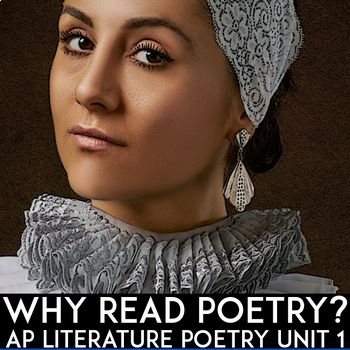AP Literature and Composition Poetry Unit 1 | AP Lit. & Comp. Poems | Curriculum
- Zip
Description
Worried that your AP poetry unit won’t teach your students to analyze literature independently?
Like many people in the history of reading poetry, your students might not quite understand the point of it all. Why does poetry have to be so hard to understand? Why so many comparing of things to other things? Why can’t they just say what they mean?
And when students are lead to believe that reading poetry means listening to lectures and parroting a teacher’s analysis, they become even more disempowered and apathetic. This kind of disillusion leads to students who don’t do well on the AP test because they think that they can’t find the answers themselves. Even worse, this kind of instruction can kill a students’ love of literature by focusing only on correct answers and inane poetry terms.
If you want your students to be empowered to analyze literature and write about their findings with fluency and clarity, you need to empower them with the skills they need to work independently, and most importantly, help them to understand why poetry is essential to human beings.
Based in the skills required by the College Board, this unit will help your classes complete the requirements for the first poetry unit including learning about character, structure, contrasts, diction, simile, and metaphor, as well as getting frequent practice writing paragraphs with claims and evidence. This unit also includes many elements which I have found to be very effective in my 15 years of teaching students to engage independently with texts and to write fluid, insightful essays. As they analyze 14 classic and lesser known poems, students will start to get a deeper understanding of how poetic elements work to create meaning in poetry.
When you teach the AP Poetry Unit 1 with this complete unit you will:
- Give your students the practice they need to become more natural and fluid writers when they write daily on engaging and compelling freewrite prompts.
- Help your students to better understand how literary elements create meaning in texts when they complete the ready-to-go close reading questions.
- Cover all of the skills and enduring understandings of the AP Literature Unit 2 when you follow the extensive, concrete plans and pacing guide in this complete unit.
- Challenge your classes to understand how authors use literary elements to create artistic effects and meaning when they explore poetry from the inside out with the structured, scaffolded poetry writing exercises.
- Help your students to become more comfortable independently analyzing texts for meaning and writing to discover meaning when they practice the step-by-step reading response structures outlined in this unit.
- Give your classes a break from the “serious work” of literary analysis when they experiment with fun, low-key, engaging creative writing exercises focusing on poetry writing.
- Improve your students’ writing skills when they complete the focused, structured activities on paragraph structure including a handout for topic sentences focusing on “Theme for English B” and a parts of the paragraph handout for students to use for practice.
- Quickly and easily grade students’ practice paragraphs when you utilize the included literary analysis paragraph rubric.
- Know that your unit will be a success when you incorporate practices, techniques, and activities that have been tested with hundreds of AP students.
- Prepare your students with the skills they need for the AP test as well as for classes in college and beyond.
Texts Included in the Unit
“First Fig” by Edna St. Vincent Millay
“When People Ask Me How I’m Doing” by Rudy Fransisco
“How to Eat a Poem” by Eve Merriam
“Introduction to Poetry” by Billy Collins
“Instructions for Life” Mary Oliver
“Siren Song” by Margaret Atwood
“Theme for English B” by Langston Hughes
“Digging” by Seamus Heaney
“Litany for Survival” by Audre Lorde
“so you want to be a writer” by Charles Bukowski
“The Secret” by Denise Levertov
“Astrophil and Stella 1: Loving in truth, and fain in verse my love to show” by Sir Philip Sidney
Sonnet 38, “[How can my muse want subject to invent]” by William Shakespeare
“This is Just to Say” by William Carlos Williams
“Variations on a Theme” by Keneth Koch
Teaching other classes besides AP Literature? All of the units in this resource are differentiated for teaching with standard classes as well, so you can teach the same texts with other classes. If you’re not teaching this unit for an AP class, you might choose to slow down, give less homework, and stretch out a bit! This unit is very adaptable!





